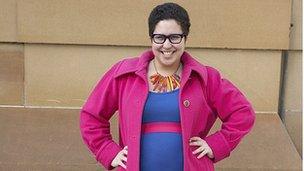'Fatshion' blogs defiantly celebrate plus-size couture
- Published
Clothing designer Qristyl Frazier describes the thrill of creating 'plus-sexy' fashions
Tired of being ignored, "fatshionistas" are using the web to reclaim their autonomy and show off their wardrobe.
For fat people, the rules of fashion are short but strict: stick to muted tones; avoid stripes and large patterns; stick to flowing shapes; spandex is a privilege, not a right.
In short, dress to disguise and disappear.
But not everyone has taken on board that message.
The internet is awash with images of fat men and women proudly flaunting their stuff in bright tights, colourful patterns, short hemlines and other fashion-forward creations.
Outside the mainstream
Sites like Hey Fat Chick, external, Chubby Guy Swag, external, The Manfattan Project, external and Plump Up the Volume, external celebrate images of big bodies in bold clothes.
They are defiant sites, and proudly so - some of the most popular have names too profane to publish here.
"The mainstream fashion world excludes and ignores plus-size women. It tries to keep us out of the conversation," says Frances Lockie, an Australian who runs Hey Fat Chick, in an email to the BBC.
"In response, through fatshion Tumblrs and blogs, it's like we've invented our own language."
A new language is often needed for those who feel outside the mainstream of Western fashion and culture.
'Marginalised'
Marianne Kirby, author of Lessons from The Fat-o-Sphere: Quit Dieting and Declare a Truce with Your Body, says: "I'm a size 28.
"I have a completely different way of interacting in my body with the rest of the world than someone who's 6ft tall and a size 12. Part of it is ratios, and some of it is how fat behaves.

Frances Lockie started a site to show more representations of fat women
"Everyone has to extrapolate to a certain degree, but I think fat bodies are often so different that it's useless to look at a garment on someone who weighs 150lb less than I do."
While few people can claim to wear clothes in the same way runway models do, fat women often feel completely adrift due to a lack of media representation.
"Growing up I could watch TV and movies and see someone that sort of looked like me," says Lesley Kinzel, author of the soon-to-be-published book Two Whole Cakes, a guide to body acceptance.
"It gives the feeling that I'm represented and I belong in the world. These days I feel like it's harder to find, especially for young people."
The internet, she says, allows fat people who feel marginalised to create their own validation without waiting for the media to get on board.
Self-loathing
"I established Hey Fat Chick because I was sick of never seeing positive representations of the fat female body in media," says Ms Lockie.

Beth Ditto often appears on "fatshion" Tumblrs
"It was through my searching for fat positive pictures and quotes that I found the online fat acceptance movement.
"By reading these blogs, I discovered that there was cultural theory behind why I never saw fat women celebrated, or even presented as normal."
Fat activism and fat fashion have often gone hand in hand, and the internet has long been a safe space for fat men and women to declare their refusal to "hide" until they reach a smaller size.
Many fat activists instead believe in adopting healthy habits, abandoning yo-yo dieting and self-loathing, and loving one's body the way it is, rather than waiting for a weight loss that may never come.
It's a radical stance, and one that's often discovered on the search for a perfect pair of pants.
"In my experience, fashion is really a gateway drug to activism," says Ms Kinzel.
"In the beginning, it's coming from a really selfish place - I want to wear this, but I'm tired of dieting.
"Very often that will lead to people starting to question all the conventional wisdom around weight, including whether dieting is a waste of time."
Outfit of the day
Ms Kinzel was one of the original moderators for the Live Journal's "Fatshionista, external" forum, an earlier predecessor of the Tumblr blogs.
Started in 2003, the forum allows women to post photos of their "outfit of the day" (OOTD), while comparing notes about sales, new stores, and plus-sized fashion resources.
Though the Fatshionista community still exists, it is Tumblr that has hosted most of the newer sites.
Aside from a feature that allows readers to submit their photos to individual blogs, blog administrators can "reblog" content from other Tumblrs, sharing that information with their readers. A series of common tags across all blogs allows Tumblr readers to search for photos by topic.
One tag, "Fatshion February" was intended to be used only as a one-off for participants posting their outfits every day for a month. Almost a year later, it has taken on new life.
"It's one of the first things I search for [on Tumblr], because it's become this code word," says Ms Kirby.
An uphill battle
For many, the sites serve as both inspiration and validation.
"I've gotten messages that say you've inspired me to wear what I want to wear no matter what people think," says Mandy Fierens, the author of the Curvy Model blog.
Her OOTD photos have been reblogged on other fat fashion sites.

Mandy Fierens posts her outfits on her Tumblr blog
"I didn't start the blog to make a difference," she says, but loves that her photos are helping others to accept their bodies.
Of course, it will take more than a vocal web community to change years of anti-fat dogma.
"I still feel the pressure to dress my body in a certain way to mitigate my fatness; that is, to make my body as small and invisible as possible," says Ms Lockie.
"Bold fashion is my accessible and effective form of daily activism. It fights back against the ridiculous fashion rules for fat girls.
"When I wear something bright or tight or both, I am forcing people to recognise me and recognise my body the way I dictate it. My clothes are my protest placard."